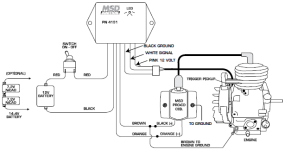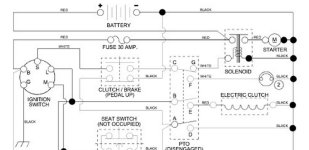jabel
New member
- Joined
- Oct 8, 2012
- Messages
- 12
Well your getting excellent advice & help from these fellas,cause you need to pinpoint what its doing &/or not doing correctly b4 you can/shld proceed! The art &/or science of good troubleshooting is to know the system, that being said, you shld at least know the basics or at least know how to use your tools & what to use,why & where! Once you know what items do what,how & why,it becomes much easier & simpler to trblsht/diagnose! Also a good wire diagram/shematic does wanders too, if you dont know where wires are supposed to be & what color,how can you possbly discern the problems? All that aside, If you have a voltmeter, all you really have to do is check for voltage here & there at the right places & at the rght times, like the guy said, about 14 volts while its running & about 12 when its off! If you check for volts,your checking for power! If there is no voltage where there is supposed to be,then your not getting power to that place/circuit/switch/relay/fuse/light etc!! It sounds a lot like a faulty or missing voltage regulator to me, a bad one will drain the batt really fast! Also check your stator & stator wires & stator field windings, check to see if any of the wires are getting hot while its running! Always check the easy,obvious stuff first, it will save you money a lot of times! I've seen car's whole elec system shut dwn & not take a jump start just from a corroded battery terminal(usually positive) ! Always disconnect the ground/negative term 1st & hook it up last! You know how the guy(s) said the mower shld run w/o the batt? Well,once your veh starts(tractor or car) , it really runs off the alternator(or generator) , the battery's most imp role is in starting/cranking power for starter & initial system voltage, from then on, the alternator takes over & also charges the batt! Newer cars have regulators built into the alternator(although still seperate inside) whereas older units had sep voltage regulators, & when you had a drastic change in charging(under or over charging) it was generally an indication of a bad voltg reg! Sometimes the batery wld be swollen/convex on one side & concave on the other! W/o the reg,the alternator is very simple, the reg is the "brain" of the charg systm & is moree sensitive & much more likely to be a culprit than the stator/alternator! With riding mowers, the vltg reg also serves as a "rectifier" which changes "DC"(direct current-ie 12-14volts) into A/C ( alternating current)(which is the opposite of an inverter,which changes "DC"currenttt into "A/C & if I'm not mistaken, the "coil" then "amplifies/multiplies" (makes voltage much higher) for ignition! It takes a lot more than 12-14 volts to fire the spark plug(s). If tou buy a gd multimeter( an electrcl meter which usually measures voltage;d/c & a/c , ohms(resistance) in diff levels(which can also be used to check for "Continuity", another way to see if power is getting thru so to speak, ie the circuit is unbroken & to check for Current/Amps in D/C mode only or amps/current in BOTH D/C & A/C! ( some will only measure in "D/C" bec it dsnt take much current/amps to "Fry" something! I was gonna say if you get a "decent" multi-meter, it shld have instructions on how to check diff values (like amps,volts, ohms etc as well as how to check relays & solonoids(& injectors etc) Good luck !!

